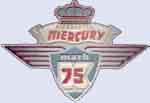From a previous posting, something I thought was some kind of saw horse queen joke are a couple of samples of open bearings with an inside bushing to support the top of a class A-B crankshaft at the top of the crankcase. If those bearings were supposed to run open in the air, did some leakage through the bronze bushing below it leak enough to lubricate the open bearing? Or did the driver turn around with a squirt can of oil to give it a periodic shot while underway, racing?
Featured also are what most would expect. A bearing housing that housed 2 ball bearing sets and a top seal yet here are these open bearings and they are both snap ringed to keep the bearing against the housing and stop them from moving up or out too. There is no evidence that there was ever any oil / grease seal on one or both sides of the inserted now open to air ball bearings either. Something weird here I can't explain. Anyone have any light to shed on this weird way of running top of crankshaft bearings?


 Thanks:
Thanks:  Likes:
Likes: 







Bookmarks